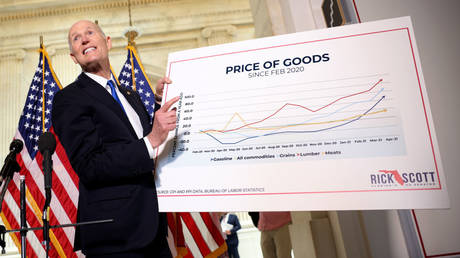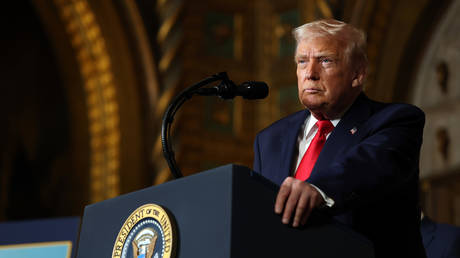
New figures show that on trade, economic growth and inflation, China’s comprehensively come out on top and US sanctions have failed miserably
The news that US inflation has reached its highest level for 40 years, at 7.5% in January, is the most explicit indicator of serious problems in its economy. The monetary tightening that will be used to attempt to bring this under control will both slow the US economy and inevitably spill over into major effects on the world economy.
This very high inflation is particularly significant when compared to 1.5% inflation in China, its main economic competitor, in the same month. US inflation is five times higher than China’s. These relative inflation levels have extremely restrictive effects on American economic policy – it will be forced to implement measures to slow its economy. In contrast, China, whose economy is already growing faster than the US, has room for a further economic stimulus without damaging inflationary pressures.
But this is only one of the symptoms that the US has suffered in a severe economic defeat in its competition with China. This, in turn, has major political consequences both in the US and internationally.
Analyzing first the domestic US political situation, unsurprisingly this high inflation has led to falling living standards for the overwhelming majority of the population, and has drastically undermined support for Biden’s administration. The latest average opinion polls show 54% of Americans disapprove of the Biden government, compared to only 40% approving.
The economic situation is the main driving force behind Biden’s fall in support. Polls show 68% of Americans consider the economy the most important problem confronting them, almost twice as many as those who cited Covid (37%).
Behind these political problems is the reality that the US has suffered a serious defeat in the economic war it launched against China. In 2018, America began its trade offensive by unilaterally imposing tariffs against Chinese imports. The aim of this was to reduce the US balance of trade deficit and to rebuild its manufacturing industry. But data makes it clear that the US has not achieved either.
In 2017, the last year before the US launched its trade war, its balance of goods trade deficit was $792 billion; by 2021, this had risen to $1.078 billion.
More narrowly regarding China, the US, despite its tariffs, succeeded in only slightly reducing its bilateral goods trade deficit – from $375 billion in 2017 to $355 billion in 2021. Simultaneously, the US deficit in goods trade with the rest of the world ballooned from $417 billion to $723 billion. In short, the US attempt to cut its trade deficit was a complete failure.
Neither did the US succeed in damaging China’s overall trade. Beijing’s trade surplus rose from $420 billion in 2017 to $676 billion in 2021. Last year, China’s exports and imports rose by 30%.
This comprehensive US defeat in the trade war was accompanied by equally great failure in its overall economic performance compared to China. Between 2017 and 2021, the US economy grew by 7.3%, while China’s grew by 25.1% – three times as much as the US. Since the beginning of the Covid pandemic, America’s economic performance relative to China deteriorated further. Naturally both economies slowed due to the pandemic, but since 2019 China’s economy has grown by 10.5% and the US by 2.1% – China has grown five times as much as the US.
There is no mystery regarding the reasons for this US failure. Paradoxically, the world’s supposed “number one capitalist economy” is now actually creating very little capital. Instead, the US has become an economy overwhelmingly dominated by consumption – short-term gratification instead of long-term investment in development. By 2020, the latest available data shows that US net capital creation, after taking depreciation into account, was only 1% of US Gross National Income. This is less than 10% of its level at the height of the US post-war boom in the 1960s. Such a level of investment means that the US is scarcely expanding its capital stock – consequently its economic growth is very slow.
There are rational and well-known technical ways to tackle these problems. But they would require sharp changes in Washington’s foreign and domestic policy.
The huge level of US military expenditure, $905 billion in 2021, higher than the next seven countries combined, could be sharply cut, releasing major resources for investment – but that would require an abandonment of aggressive US foreign policy.
Abandoning trade tariffs against China, which costs every US household hundreds of dollars a year, would reduce inflation – but would require abandoning the aggressive trade war against China.
The grotesquely inefficient US healthcare system, using 19.7% of GDP but creating one of the lowest levels of life expectancy in any advanced economy, could be rationalized, releasing huge resources for investment – but that would require confronting and defeating entrenched special interest groups in the US.
As long as the US is not prepared to undertake such major changes, it will suffer slow growth. Meanwhile, China’s economy will continue to grow much more rapidly. The economic defeat of the US by China in the trade war, and the way it has dealt with the economic consequences of the Covid pandemic, are just the latest expressions of this.
Regrettably, this economic win by China is unlikely to reduce US hostility. Like a cornered tiger, America may become even more aggressive – as shown in its recent policies on Ukraine and Taiwan. There is no point in trying to reason with a tiger and showing any weakness will simply increase its attacks. The only successful policy is to use strength to deter and impose defeats on it. That’s what China has achieved in its ongoing economic victory over the US.




